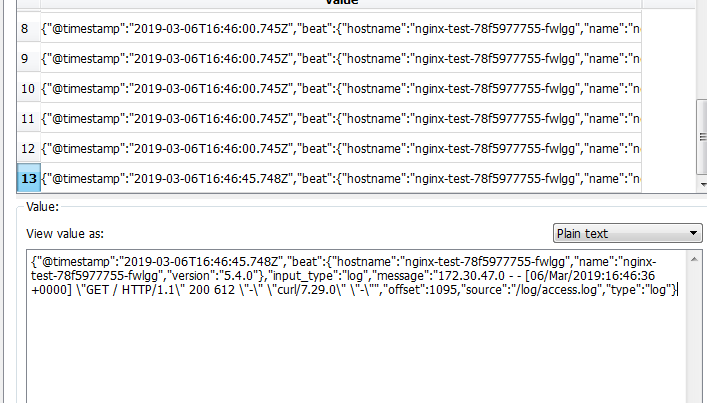#(1) Download filebeat
https://artifacts.elastic.co/downloads/beats/filebeat/filebeat-5.4.0-linux-x86_64.tar.gz
#(2) build filebeat image
1) prepare the dockerfile file
# cat dockerfile
FROM docker.io/centos
WORKDIR /usr/local
COPY filebeat-5.4.0-linux-x86_64.tar.gz /usr/local
RUN cd /usr/local && \
tar xvf filebeat-5.4.0-linux-x86_64.tar.gz && \
rm -f filebeat-5.4.0-linux-x86_64.tar.gz && \
ln -s /usr/local/filebeat-5.4.0-linux-x86_64 /usr/local/filebeat && \
chmod +x /usr/local/filebeat/filebeat && \
mkdir -p /etc/filebeat
ADD ./docker-entrypoint.sh /usr/bin/
RUN chmod +x /usr/bin/docker-entrypoint.sh
ENTRYPOINT ["docker-entrypoint.sh"]
CMD ["/usr/local/filebeat/filebeat","-e","-c","/etc/filebeat/filebeat.yml"]2) prepare docker-entrypoint.sh
# cat docker-entrypoint.sh #!/bin/bash config=/etc/filebeat/filebeat.yml env echo 'Filebeat init process done. Ready for start up.' echo "Using the following configuration:" cat /etc/filebeat/filebeat.yml exec "$@" [root@fs02 logs]# cat docker-entrypoint.sh #!/bin/bash config=/etc/filebeat/filebeat.yml env echo 'Filebeat init process done. Ready for start up.' echo "Using the following configuration:" cat /etc/filebeat/filebeat.yml exec "$@"
3) construction
docker build -t registry.cn-hangzhou.aliyuncs.com/wangfang-k8s/filebeat-v5.4.0:latest .
At the same time, I upload the image to alicloud
docker push registry.cn-hangzhou.aliyuncs.com/wangfang-k8s/filebeat-v5.4.0:latest
#(3) prepare resource list
1) prepare the filebeat configuration file,
This configuration file means to collect all files under the / log / directory and output them to redis
# cat configmap.yaml
apiVersion: v1
kind: ConfigMap
metadata:
name: filebeat-config
data:
filebeat.yml: |
filebeat.prospectors:
- type: log
paths:
- "/log/*"
output.redis:
hosts: ["192.168.1.51:6379"]
key: "nginx-log"
db: 2
tag: "nginx-log"
password: "redhat"
port: 63792) prepare the deployment configuration list file of NGINX
The nginx container and the filebeat container run in a pod. The container logs of nginx are in the / var/log/nginx directory of, and the filebeat is mounted in the / log directory of, so you can see the logs of nginx in the / log directory of filebeat
# cat nginx-deployment.yaml
apiVersion: extensions/v1beta1
kind: Deployment
metadata:
name: nginx-test
namespace: default
spec:
replicas: 1
template:
metadata:
labels:
k8s-app: nginx-test
spec:
containers:
- image: registry.cn-hangzhou.aliyuncs.com/wangfang-k8s/filebeat-v5.4.0
imagePullPolicy: Always
name: filebeat
volumeMounts:
- name: app-logs
mountPath: /log
- name: filebeat-config
mountPath: /etc/filebeat/
- image: nginx:1.11
name : nginx-test
imagePullPolicy: Always
ports:
- containerPort: 80
volumeMounts:
- name: app-logs
mountPath: /var/log/nginx
volumes:
- name: app-logs
emptyDir: {}
- name: filebeat-config
configMap:
name: filebeat-config3) prepare the resource configuration list file of nginx service
# cat service.yaml
apiVersion: v1
kind: Service
metadata:
name: nginx-test
spec:
selector:
k8s-app: nginx-test
ports:
- name: http
nodePort: 38888
port: 89
protocol: TCP
targetPort: 80
type: NodePort4) deployment
kubectl apply -f .
Normal operation of container
5) visit nginx
curl 172.30.5.3:80
6) log in to redis to check whether there is a log
Indicate if there is any problem with the log